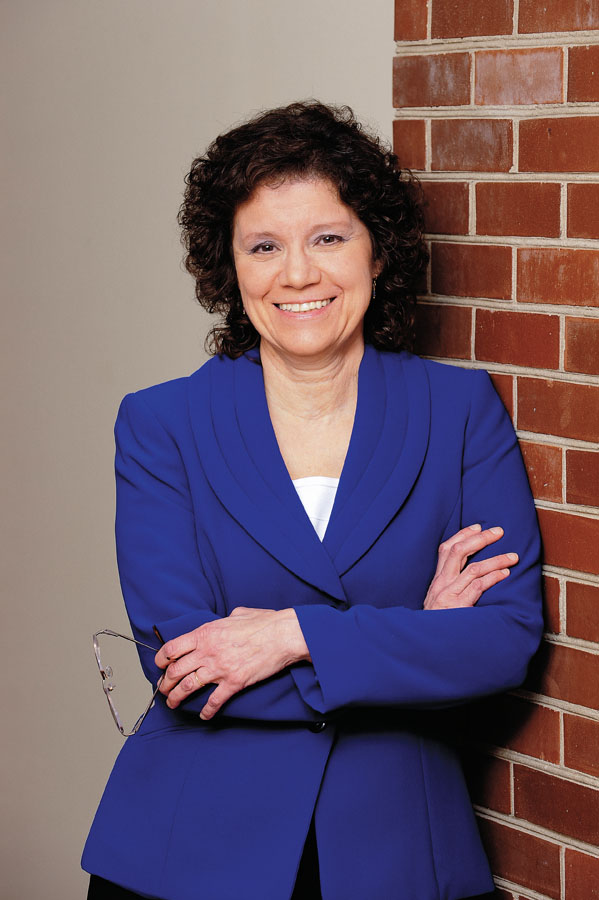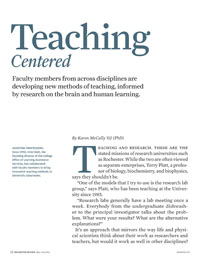Features
Teaching and research. These are the stated missions of research universities such as Rochester. While the two are often viewed as separate enterprises, Terry Platt, a professor of biology, biochemistry, and biophysics, says they shouldn’t be.
“One of the models that I try to use is the research lab group,” says Platt, who has been teaching at the University since 1985. “Research labs generally have a lab meeting once a week. Everybody from the undergraduate dishwasher to the principal investigator talks about the problem. What were your results? What are the alternative explanations?”
 ASSISTING PROFESSORS: Since 1990, Vicki Roth, the founding director of the College Office of Learning Assistance Services, has collaborated with faculty members to bring innovative teaching methods to University classrooms. (Photo: Brandon Vick)
ASSISTING PROFESSORS: Since 1990, Vicki Roth, the founding director of the College Office of Learning Assistance Services, has collaborated with faculty members to bring innovative teaching methods to University classrooms. (Photo: Brandon Vick)It’s an approach that mirrors the way life and physical scientists think about their work as researchers and teachers, but would it work as well in other disciplines?
Platt is among a group of faculty members across the University who have joined with learning specialists on Rochester’s professional staff and Provost Ralph Kuncl to explore such questions. They've established a set of initiatives to help faculty share teaching methods and to encourage new research-based approaches that have emerged over the past few decades.
Those initiatives—the Year One program for new faculty, the Future Faculty Initiative for aspiring academics, the Sharing Innovations in Teaching lunchtime seminar series, among others—cover a wide range of topics. How humans learn. Group dynamics. How to assess students’ progress. And using technology creatively and effectively.
In the coming academic year, the College plans to launch a Center for Excellence in Teaching and Learning that promises to bring a new focus to the role of teaching and to serve as a hub in which faculty as well as graduate teaching assistants across the disciplines in Arts, Sciences, and Engineering can discover and share approaches to teaching.
Vicki Roth, the director of the College Office of Learning Assistance Services, will oversee the center, while its day-to-day operations will be in the hands of Jennifer Hadingham, a pedagogy expert from the University of the Witwatersrand in South Africa.
In January, in his annual address to the Faculty Senate, Kuncl cited two landmark studies that drew on the latest research in neuroscience and psychology to suggest teaching practices in higher education need to change: a 1998 report funded by the Carnegie Foundation, Reinventing Undergraduate Education; and a 2000 National Research Council report, published as a book, How People Learn: Brain, Mind, Experience, and School (National Academies Press).
“What we now know about the conditions most conducive to learning,” said Kuncl, referring to the reports, “flies in the face of most traditional approaches to teaching.”
In higher education, perhaps the most universal approach—and one that has distinguished it from education at the secondary level—is one in which a professor lectures and a classroom of students, from as few as 20 to well over 200, take notes.
Judith Fonzi, an associate professor at the Warner School and the director of its Center for Professional Development and Education Reform, advances one explanation why the lecture has proved so enduring.
For a long time, she says, “we thought that people were just these empty vessels. And you just had to tell them clearly enough what you wanted them to learn, and all they had to do was listen carefully enough, and of course, practice it enough, and then they would know it, whatever the ‘it’ was.”
As masters of their subjects, professors have a great deal to tell their students. And their students have tended to be young adults, who, it’s been long assumed, don’t need or benefit from the educational strategies necessary to engage younger learners.
But recent research on the brain challenges those assumptions. Fonzi taught mathematics at the kindergarten through graduate school level before becoming a specialist in math education and instructor of aspiring math teachers. When she became director of the Warner Center, she says, “I had to start thinking about education in other areas, and I discovered that there was a kernel that was in common, and it didn’t matter what you were teaching, or really even who you were teaching.”
That kernel involves taking students beyond mere information gathering and helping them develop real knowledge.
“We can share information, but it’s just information,” says Fonzi. “It doesn’t become something that’s learned, or knowledge that students have gained, until they actually do something with that.”
Educators call this type of learning “inquiry-based.” Active rather than passive, inquiry-based learning draws information out from within a framework, such as a research question or hypothesis that students pursue themselves, with guidance from the instructor and interaction with fellow students. Inquiry-based learning is what faculty do in their research.
Teaching Resources at Rochester
The new College Center for Excellence in Teaching and Learning builds on the work of several programs and offices at Rochester designed to enhance the quality of teaching at the University.
- Center for Workshop Education: www.rochester.edu/college/CWE
- Leadership in Education: www.rochester.edu/ucis/leadershipineducation.htm
- Office of Faculty Development, School of Medicine and Dentistry: www.urmc.rochester.edu/education/faculty-development
- College Teaching, Learning, and Technology Roundtable: www.rochester.edu/college/ctltr
- UR Year One: www.rochester.edu/diversity/faculty/uryearone
- Future Faculty Initiative: www.rochester.edu/provost/futurefaculty
In fall 1995, the College embraced inquiry-based teaching with the introduction of “Quest” courses. Designed for freshmen, Quest courses permit a small number of students with a shared interest to explore that interest, together under the guidance of a professor, through research. Faculty leading such courses teach students how to formulate good questions, develop reliable methods for exploring them, use a variety of sources, and draw conclusions.
But do the advantages of inquiry-based learning mean that the lecture is outmoded? To the extent there’s consensus, the answer is “no” at Rochester. But the lecture should be supplemented by other, inquiry-based course components, say faculty members such as
Alyssa Ney, the James P. Wilmot Assistant Professor of Philosophy in the College. Among her courses is Introduction to Philosophy, a survey of the works of notable thinkers, from antiquity to modernity, and their ideas on topics such as the nature of truth, relativism, and free will. The class seems made for lively discussion.
But, says Ney, “You still need lectures.” Using the example of the 17th-century French philosopher René Descartes, she says, “there are certain facts about what Descartes did say and what he didn’t.” At the introductory level, students need that clarification to grasp the complexities they encounter in their readings.
Platt, too, says lectures are an important component in his Introduction to Biochemistry course.
“My job as a lecturer is to illuminate—to help students make the connections,” he says. “And in courses like biology where the content is enormous, it’s to help them sort out the wheat from the chaff.”
Platt is also codirector, along with Roth, of Rochester’s Center for Workshop Education, a pioneering effort to use a workshop model based on “peer-led team learning.” Workshops are groups of about 10 students who work through problems collaboratively, guided by a trained peer facilitator who has performed well in the same course, usually as recently as the previous year.
In 1995, the late Jack Kampmeier, a professor of chemistry and former dean of the College of Arts and Sciences, joined with Roth to craft a workshop model for Kampmeier’s organic chemistry class. Rochester joined an early consortium of universities that had experimentally adopted the workshop model.
Students registered for the course could choose to sign up for either a workshop or a traditional recitation. Roth, who had already been experimenting with forming student-led study groups, recalls they divided roughly in half. And when the grades were in, “the half of the class in workshops did so much better than the half in recitations that we were quite sure we were doing something useful.”
Roth, who has worked with faculty for nearly two decades to hone the workshop model and train peer leaders, says the workshop model spread largely through informal networks—through students talking to professors and through professors in one department talking with counterparts in another. In 1996, Kampmeier made workshops universal in organic chemistry, and the model spread to other courses and other departments largely in response to student demand.
In recent years, they’ve been adopted in select courses at the Simon School and the School of Nursing as well. Formal studies at other universities as well as one coauthored by Roth, Kampmeier, and Platt have shown over several years that students in workshops consistently scored higher on exams, earned more grades of A or B, and had lower rates of withdrawal from the courses than student in recitations.
Faculty who have used workshops argue that a peer leader is essential. Ney says she wishes that she could see her Introduction to Philosophy workshops in action. “But if I were to sit in, it would just disrupt the whole dynamic,” she argues. When the professor leads discussion, she says, students become “very tentative in their responses. They’ll look at me and wonder ‘Well, what is she looking for?’” rather than develop confidence in evaluating their own arguments and conclusions.
Platt, too, says that working under the guidance of a peer leader forces students to wrestle with problems rather than look at an authority to provide answers.
“In real science, when you get an answer, there’s not a thunder clap from on high telling you ‘Hey! You got the right answer!’ Or ‘Nope, sorry, that’s wrong.’ You have to, among other things, develop the tools to decide what confidence level you have in your answer, and maybe at the same time, what are the alternative explanations for your answer that you can now test with a subsequent experiment,” he says.
What’s also compelling about the workshop method, faculty note, is that it’s an innovation that is not based on new technology.
Discussions about student engagement often lead to questions such as, Which technologies, used in which ways, enhance student engagement? And are there ways in which technology can undermine it?
“It’s a challenge for any instructor to sort from all of the burgeoning educational technology that’s out there,” says Roth. “Almost every day there’s something new or emerging. How do you sort out what’s useful or valuable out of any of that for the sort of things that you want to do as an instructor?”
Based on the “prototypes” of the initiatives already in place, the goals of the new center include helping foster such discussions so that new, aspiring, and senior faculty can find support and resources for their roles as teachers.
Fonzi says she hopes the center, which will begin in the College, will eventually become a resource for the entire University.
Right now, she says, many University-wide teaching initiatives have no permanent home. The Future Faculty Initiative “is running out of the briefcases of six or eight of us who put it together and keep it going.” The same is true, she says, of the Leadership in Education cluster, an informal group of faculty, staff, graduate students, and postdocs who organize the Sharing Innovations in Teaching lunchtime seminars.
Roth, who will oversee the College’s new center for teaching as it gets under way later this year, hopes the new initiative sparks a robust discussion about teaching at Rochester.
“A faculty member may bring us something that they want to share,” says Roth about her vision for the center. “They may have just tried a new idea. It doesn’t have to be earth shattering. It doesn’t have to be paradigm shifting. But maybe it’s a small way that they’ve made something go better.”

